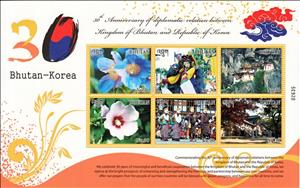Mini Sheet: Diplomatic Relations with South Korea, 30th Anniversary (Bhutan 2017)
Diplomatic Relations with South Korea, 30th Anniversary (Bhutan 2017)
22 September (Bhutan ) within release Diplomatic Relations with South Korea, 30th Anniversary goes into circulation Mini Sheet Diplomatic Relations with South Korea, 30th Anniversary face value 180 Bhutanese ngultrum
| Mini Sheet Diplomatic Relations with South Korea, 30th Anniversary in catalogues | |
|---|---|
| Colnect codes: | Col: BT 3027-07MS |
Mini Sheet is square format.
Also in the issue Diplomatic Relations with South Korea, 30th Anniversary:
- Mini Sheet - Diplomatic Relations with South Korea, 30th Anniversary face value 180;
- Souvenir Sheet - Diplomatic Relations with South Korea, 30th Anniversary face value 60;
- Mini Sheet - Diplomatic Relations with South Korea, 30th Anniversary face value 60;
- Mini Sheet - Diplomatic Relations with South Korea, 30th Anniversary face value 180;
Mini Sheet Diplomatic Relations with South Korea, 30th Anniversary it reflects the thematic directions:
Architecture (Latin architectura, from the Greek ἀρχιτέκτων arkhitekton "architect", from ἀρχι- "chief" and τέκτων "builder") is both the process and the product of planning, designing, and constructing buildings and other physical structures. Architectural works, in the material form of buildings, are often perceived as cultural symbols and as works of art. Historical civilizations are often identified with their surviving architectural achievements.
Dance is an art form, often classified as a sport, consisting of sequences of body movements with aesthetic and often symbolic value, either improvised or purposefully selected. Dance can be categorized and described by its choreography, by its repertoire of movements or by its historical period or place of origin. Dance is typically performed with musical accompaniment, and sometimes with the dancer simultaneously using a musical instrument themselves.
Diplomacy is the main instrument of foreign policy which represents the broader goals and strategies that guide a state's interactions with the rest of the world. International treaties, agreements, alliances, and other manifestations of international relations are usually the result of diplomatic negotiation and processes. Diplomats may also help shape a state by advising government officials.
A flower, sometimes known as a bloom or blossom, is the reproductive structure found in plants that are floral (plants of the division Magnoliophyta, also called angiosperms). The biological function of a flower is to effect reproduction, usually by providing a mechanism for the union of sperm with eggs. Flowers may facilitate outcrossing (fusion of sperm and eggs from different individuals in a population) or allow selfing (fusion of sperm and egg from the same flower). Some flowers produce diaspores without fertilization (parthenocarpy). Flowers contain sporangia and are the site where gametophytes develop. Many flowers have evolved to be attractive to animals, so as to cause them to be vectors for the transfer of pollen. After fertilization, the ovary of the flower develops into fruit containing seeds. In addition to facilitating the reproduction of flowering plants, flowers have long been admired and used by humans to beautify their environment, and also as objects of romance, ritual, religion, medicine and as a source of food.
Flora is the plant life occurring in a particular region or time, generally the naturally occurring or indigenous—native plant life. The corresponding term for animal life is fauna. Flora, fauna and other forms of life such as fungi are collectively referred to as biota. Sometimes bacteria and fungi are also referred to as flora, as in the terms gut flora or skin flora.





